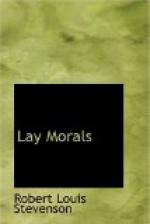As you continue to look at these pictures, about an inch square for the most part, sometimes printed three or more to the page, and each having a printed legend of its own, however trivial the event recorded, you will soon become aware of two things: first, that the man can draw, and, second, that he possesses the gift of an imagination. ‘Obstinate reviles,’ says the legend; and you should see Obstinate reviling. ‘He warily retraces his steps’; and there is Christian, posting through the plain, terror and speed in every muscle. ‘Mercy yearns to go’ shows you a plain interior with packing going forward, and, right in the middle, Mercy yearning to go—every line of the girl’s figure yearning. In ’The Chamber called Peace’ we see a simple English room, bed with white curtains, window valance and door, as may be found in many thousand unpretentious houses; but far off, through the open window, we behold the sun uprising out of a great plain, and Christian hails it with his hand:
’Where am I now! is this the love and care
Of Jesus, for the men that pilgrims are!
Thus to provide! That I should be forgiven!
And dwell already the next door to heaven!’
A page or two further, from the top of the House Beautiful, the damsels point his gaze toward the Delectable Mountains: ’The Prospect,’ so the cut is ticketed—and I shall be surprised, if on less than a square inch of paper you can show me one so wide and fair. Down a cross road on an English plain, a cathedral city outlined on the horizon, a hazel shaw upon the left, comes Madam Wanton dancing with her fair enchanted cup, and Faithful, book in hand, half pauses. The cut is perfect as a symbol; the giddy movement of the sorceress, the uncertain poise of the man struck to the heart by a temptation, the contrast of that even plain of life whereon he journeys with the bold, ideal bearing of the wanton—the artist who invented and portrayed this had not merely read Bunyan, he had also thoughtfully lived. The Delectable Mountains—I continue skimming the first part—are not on the whole happily rendered. Once, and once only, the note is struck, when Christian and Hopeful are seen coming, shoulder-high, through a thicket of green shrubs—box, perhaps, or perfumed nutmeg; while behind them, domed or pointed, the hills stand ranged against the sky. A little further, and we come to that masterpiece of Bunyan’s insight into life, the Enchanted Ground; where, in a few traits, he has set down the latter end of such a number of the would-be good; where his allegory goes so deep that, to people looking seriously on life, it cuts like satire. The true significance of this invention lies, of course, far out of the way of drawing; only one feature, the great tedium of the land, the growing weariness in well-doing, may be somewhat represented in a symbol. The pilgrims are near the end: ‘Two Miles Yet,’ says the legend. The road goes ploughing up and down over a rolling heath; the wayfarers, with




